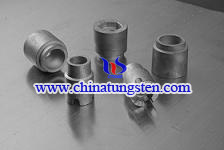Tungsten Rocket Nozzle & Tungsten Jet Vanes Nozzle
What is Nozzle?
A nozzle, usually specially shaped and made of tungsten, for producing a jet, such as the exhaust nozzle on a jet, called tungsten jet vanes nozzle or rocket engine, called tungsten rocket nozzle.
Nozzle is a duct, tube, pipe, spout, or the like through which a fluid is directed and from the open end of which the fluid is discharged, designed to meter the fluid or to produce a desired direction, velocity, or shape of discharge.tungsten jet vanes nozzle and tungsten rocket nozzle converts potential energy into kinetic energy, commonly expressed as the ratio of the actual change in kinetic energy to the ideal change at the given pressure ratio.
How Tungsten Rocket Nozzle and Tungsten Jet Vanes Nozzle Work?
Rocket motors are limited in their performance by the energy content of their propellants and the need to carry their oxidizer with them. Rocket motors do, however, provide near-instantaneous thrust and are not limited to atmospheric operation.
To try to improve the delivered energy of rocket motors, many methods have been employed. The energy of the fuels and oxidizers have been increased, tungsten rocket nozzle has been contoured and modified to improve their efficiency and the operating pressures have been increased. However, the delivered propellant specific impulse (a measure of the thrust produced per unit mass of propellant) has not appreciably changed since the 1950's. Another approach has been to use so-called “ducted rockets,” which bring air into the combustion chamber via inlets and flow ducts, where the air combines with the propellant gases to increase the specific impulse of the propellant. While ducted rockets have been investigated since at least the mid 1960's, they have never progressed beyond the prototyping stage because of their inherent difficulties and complexity. In particular, bringing air into the combustion chamber uses much available volume which could otherwise be used for propellant and subjects the duct materials to extremely harsh thermal and flow conditions. To date, no one has been able to overcome these problems with sufficient success to justify the increased cost and complexity. The present product, an afterburning aerospike tungsten rocket nozzle, improves the delivered energy density of rocket motors, with less complexity than ducted rocket motors.
Jet engines use air to provide their oxidizer, but are either inherently complex (e.g., turbojets and turbofans) or provide no thrust at zero initial speed (ramjets). Because of their use of atmospheric oxygen, jet engines cannot operate in space and take a considerable period of time to “spool-up” to full thrust. Jet engines also tend to need substantial levels of maintenance and are quite costly to acquire, maintain and operate. Rocket motors (particularly solid fuel rocket motors) tend to be relatively inexpensive to acquire, require minimal maintenance and virtually nothing to operate.
Tungsten alloy has a very high melting point and has a density twice that of steel and are more than 50% heavier than lead is suitable material for tungsten rocket nozzle and tungsten jet vanes nozzle making.

If you got any enquiry or question about tungsten rocket nozzle and tungsten jet vanes nozzle, please do not hesitate to contact us at sales@chinatungsten.com, sales@xiamentungsten.com. Tungsten jet vanes nozzle price will be offered based on size, density, quantity, hardness, and any other specific requirements.






 sales@chinatungsten.com
sales@chinatungsten.com